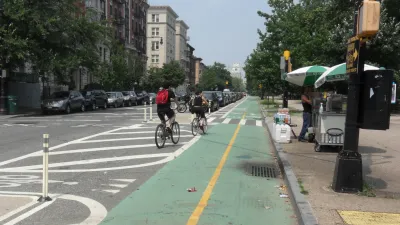While Angie Schmitt doesn't ask this question in her article on the movement behind these lanes, she writes that cities without them "are being left behind". They're popular because they effectively address the #1 reason for not riding: safety

You may know them as 'green lanes' or 'cycle tracks' - they are "a special class of premium bike infrastructure" in which the bike lane is separated from car traffic by several means. It could be a row of parked cars or plastic bollards; sometimes it's just striped paint. "As planners look for more permanent options, more formidable obstacles like landscaping planters or curbs are being used," Schmitt writes.
In this comprehensive look behind the movement toward protected bike lanes, Schmitt begins with the controversial Prospect Park West bike lane in Brooklyn, N.Y. She credits the opponents, "dismissed as irrational and parochial by cycling advocates", for knowing "how quietly revolutionary that little green stripe of pavement would be". But real credit goes to the lanes themselves for reducing "crashes and injuries of all kinds... by 63 percent".
Playing an instrumental role in the advancement of protected bike lanes is the "Green Lane Project, a nonprofit project of bike advocacy group Bikes Belong working with six cities...to install protected bike infrastructure." According to director Martha Roskowski:
Last year alone, the number of protected bike lanes in the United States nearly doubled from 62 to 102. This year, the number is expected to double again. Protected bike lanes are now in place in 32 cities across the United States.
Success is not measured by the increase in lane miles of protected lanes, but in getting more folks to take to bike pedals rather than gas pedals.
For decades, in the United States, the cycling rate has held stubbornly around 1 percent – despite the fact that almost 50 percent of trips Americans make by any mode are three miles or less. “The number one reason people don't ride is that they don't feel safe,” said Roskowski. “When we put in the protected lanes, people feel safe.”
And numbers prove Roskowski's point. As reported here on October 23, 2012, a recent study published in the American Journal of Public Health indicated that "protected bike lanes – with actual barriers separating cyclists from traffic – really make a difference. The risk of injury drops for riders there by 90 percent."
FULL STORY: The Rise of The North American Protected Bike Lane

National Parks Layoffs Will Cause Communities to Lose Billions
Thousands of essential park workers were laid off this week, just before the busy spring break season.

Retro-silient?: America’s First “Eco-burb,” The Woodlands Turns 50
A master-planned community north of Houston offers lessons on green infrastructure and resilient design, but falls short of its founder’s lofty affordability and walkability goals.

Delivering for America Plan Will Downgrade Mail Service in at Least 49.5 Percent of Zip Codes
Republican and Democrat lawmakers criticize the plan for its disproportionate negative impact on rural communities.

Test News Post 1
This is a summary

Test News Headline 46
Test for the image on the front page.

Balancing Bombs and Butterflies: How the National Guard Protects a Rare Species
The National Guard at Fort Indiantown Gap uses GIS technology and land management strategies to balance military training with conservation efforts, ensuring the survival of the rare eastern regal fritillary butterfly.
Urban Design for Planners 1: Software Tools
This six-course series explores essential urban design concepts using open source software and equips planners with the tools they need to participate fully in the urban design process.
Planning for Universal Design
Learn the tools for implementing Universal Design in planning regulations.
EMC Planning Group, Inc.
Planetizen
Planetizen
Mpact (formerly Rail~Volution)
Great Falls Development Authority, Inc.
HUDs Office of Policy Development and Research
NYU Wagner Graduate School of Public Service


























